Gross domestic product — The economy was in recession (as measured by quarter over quarter gross domestic product) from the second quarter of 2008 to the second quarter of 2009 and again in the first two quarters of 2011 after the Great East Japan Earthquake of March 2011. However, key sectors of the economy and especially domestic demand have continually suffered.
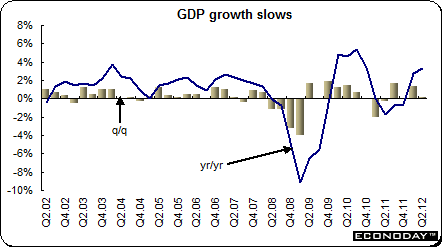
The Japanese economy plunged at an alarming rate for four quarters through the first quarter of 2009 as exports plunged and global trade dried up along with consumer spending. However, the economy rebounded in the second quarter as exports steadied and industrial production managed to rise. The economy grew for the first three quarters of 2010. However, in the fourth quarter, the economy paused. The economy declined a revised 0.9 percent in the quarter but was up a revised 2.4 percent on the year. On an annualized basis, GDP dropped 3.0 percent. The reason for the decline was attributed to the end of government stimulus packages which had pushed purchases into the third quarter.
First quarter 2011 GDP dropped 0.9 percent and was down 0.7 percent on the year. On an annualized basis, GDP sank 3.7 percent. This put Japan back into recession. The decline was attributed to the production and supply line disruptions from the earthquake and tsunami. Consumers which account for about 60 percent of GDP stopped spending in its aftermath as well. GDP declined again in the second quarter. GDP slid 0.5 percent on the quarter and 1.1 percent on the year. A rebound was anticipated in the second half of the year as rebuilding got under way. However, with vast power problems affecting operations, companies struggled to maintain rebuilding schedules. The region that was hit by the Great East Japan Earthquake accounts for about 8 percent of Japan’s total GDP.
The struggle continued in the third quarter of 2011. A short-lived rebound took place with GDP gaining 1.7 percent on the quarter. However, the recovery did not last. GDP slumped once again in the fourth quarter as floods in Thailand once again disrupted Japanese supply lines and added to difficulties in the recovery effort. GDP dropped a revised 0.2 percent in the fourth quarter. On the year, GDP was down 0.6 percent and on an annualized rate was 0.7 percent lower.
The economy rebounded in the first quarter of 2012 with the initial estimate revised to an increase of 1.3 percent on the quarter. Importantly, the decline in the fourth quarter was revised away to show that the economy was flat during the quarter. However, second quarter 2012 growth slowed to an increase of 0.2 percent on the quarter or an annualized pace of 0.7 percent.
Industrial production — Industrial production data are watched closely given the economy’s dependence on manufacturing exports to grow. This is in contrast to industrialized economies such as the UK and the U.S. who rely on the consumer to stimulate growth. Industrial production is considered one of the most important indicators for Japan given its reliance on exports for growth. Output had already been sagging prior to the March 11, 2011 disaster. Auto sector output was severely disrupted along with other major sectors. The use of rolling blackouts to conserve energy continues to upset production schedules. Production rebounded sharply following the earthquake as companies especially in the auto sector worked feverishly to repair supply line disruptions. These disruptions not only had a national impact but a global one as well. The floods in Thailand disrupted supply lines once again but output, recovered in December and January after sinking in November. After sinking in February, output rebounded 1.3 percent in March. However, production slid in April by 0.2 percent on the month and plunged 3.4 percent in May as exports felt the crimp of the global slowdown and the strengthening yen. Output remained weak in both June and July.
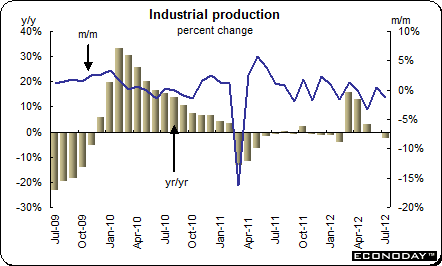
Consumer spending — Consumer spending has been the Japanese economy’s Achilles heel and an obvious drag on growth. The consumer was reluctant to spend and has certainly cut back as unemployment remains relatively high. Besides retail sales data, an important measure of consumption is household spending. After hitting lows in January 2009, both retail sales and household spending have gradually improved thanks to government stimulus packages. However, both were showing signs of weakening as the impact of the stimulus wore off before March 11th. Spending plunged in March in the immediate aftermath of the earthquake throughout Japan and not just in the immediately affected areas. Spending continues to be volatile in 2012.
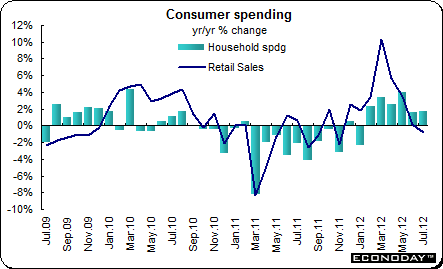
Deflation or Inflation — Japan took a step back into deflation as weak demand and the drop from record oil prices slammed the CPI. Price data in 2008 was skewed by vaulting food and energy prices. After hovering around the zero mark for several months, CPI continued to decline throughout 2010. While prices continue to drop, the rate of decline appears to be easing especially as energy prices firm. After edging up after the earthquake, the annual increase continues to hover around zero. Consumer prices were boosted after the earthquake and tsunami by energy prices. Japan shut its nuclear generating facilities and shifted to other sources of fuel which had to be imported and in turn increased the overall CPI.
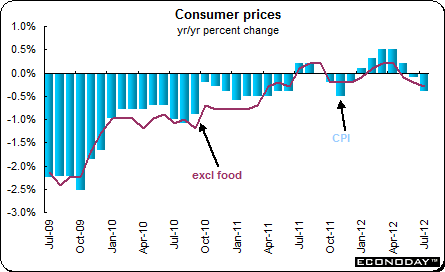
Another view of deflation emerges if one looks at the corporate goods price index, a measure of producer price inflation. The CGPI had been positive from 2004 to the end of 2008 when compared with the previous year. However, the price increases here did not affect consumer prices because demand was too weak to pass them on. After going through a negative stretch, the annual CGPI increased thanks mainly to energy prices. Now with energy prices easing, the CGPI is negative once again.
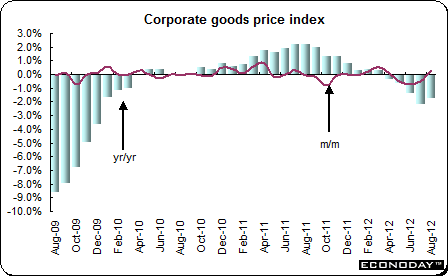
Unemployment — The unemployment rate jumped to 5.7 percent in July 2009 after hovering around 4 percent at the end of 2008 and beginning of 2009. The last time the unemployment rate had been above 5 percent was in November 2003. The rate has gradually declined. However, the rate is more a reflection of the declining labor force than an improvement in employment. The data for March, 2011 exclude the three earthquake hit prefectures (Iwate, Miyagi and Fukushima). Japan has had a problem with these data since the earthquake, especially after adding back the three earthquake hit prefectures. In 2012, the unemployment rate has remained around the 4.3 percent level.
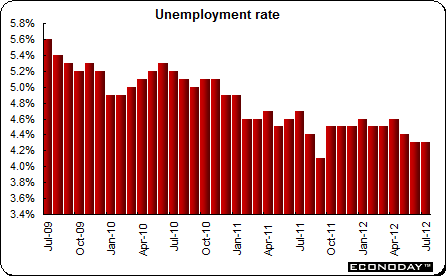
Merchandise trade imports and exports — Japan is not particularly open to foreign trade. As a percentage of GDP, the value of Japan's 2001 two way foreign trade was just 16.8 percent while in Germany, for example, was 57 percent. The closed nature of Japan's economy is also apparent in comparisons with other countries in Asia such as China, which saw foreign trade reach 42.4 percent of GDP. This is largely owing to official and unofficial restrictions on merchandise imports. These remain in place despite pressure from the United States and other trading partners in order to protect less efficient sectors of the economy. This lack of openness to foreign trade has often been cited as one of the reasons for the persistence of the structural problems in the country's economy in general and the poor productivity of companies in the non-tradable sectors in particular.
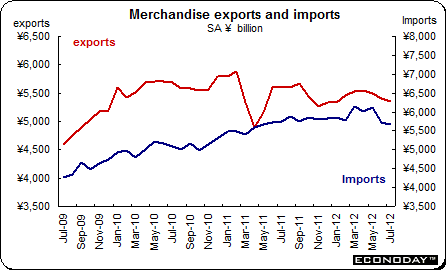
The precipitous decline in exports is one of the reasons that the economy contracted so violently in the fourth quarter of 2008 and again in the first quarter of 2009. The drop was particularly painful given the economy’s reliance on exports as a source of growth. The cutback in exports fed through to the heavy declines seen in industrial production. However both exports and imports leveled off and improved thanks to trade with China.
The critical factor in the country’s recovery will be how fast industrial output can recover so exports can resume from ports that were not destroyed by the earthquake and tsunami. Trade appeared to be recovering from March 2011 but has been vexed by the strong yen and by slowing global growth, especially in the Eurozone. In July 2012, the unadjusted merchandise trade deficit was ¥325 billion. Japan's trade continues to be hurt by weak global demand and a strong yen while fuel demand is boosting imports.
|